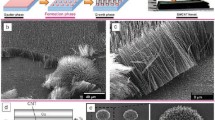Abstract
The reason for the upper limit on the height of spinnable carbon nanotube (CNT) forests was studied. To analyze the differences between CNT forests with different heights, we synthesized CNT forests using different growth times (3, 6, 9, 12, 15, and 60 min). The height of the CNT forests increased from 260 μm at 3 min to 1.7 mm at 60 min, and the spinnability decreased sharply after 9 min of growth, where a wavy morphology first appeared. Raman analysis of the CNT forest grown for 9 min showed that the intensity ratio of G-band to D-band at the upper region was 1.50 and that near the bottom was 1.14. We also found that the reaction termination process affected the spinnability of the CNT forests. Depending on the termination process, both spinnable and non-spinnable CNT forests could be selectively synthesized, because of the different morphologies in their lower regions. The results suggested that any wavy morphology produced due to a disturbance in growth conditions causes a loss of spinnability.







Similar content being viewed by others
References
Jiang KL, Li QQ, Fan SS (2002) Nature 419(6909):801. doi:10.1038/419801a
Park J, Lee K-H (2012) Korean J Chem Eng 29(3):277. doi:10.1007/s11814-012-0016-1
Zhang M, Atkinson KR, Baughman RH (2004) Science 306(5700):1358. doi:10.1126/science.1104276
Zhang X, Jiang K, Feng C, Liu P, Zhang L, Kong J, Zhang T, Li Q, Fan S (2006) Adv Mater 18(12):1505. doi:10.1002/adma.200502528
Kim JH, Jang HS, Lee KH, Overzet LJ, Lee GS (2010) Carbon 48(2):538. doi:10.1016/j.carbon.2009.09.075
Huynh CP, Hawkins SC (2010) Carbon 48(4):1105
Zhang Q, Wang DG, Huang JQ, Zhou WP, Luo GH, Qian WZ, Wei F (2010) Carbon 48(10):2855. doi:10.1016/j.carbon.2010.04.017
Kuznetsov AA, Fonseca AF, Baughman RH, Zakhidov AA (2011) ACS Nano 5(2):985. doi:10.1021/Nn102405u
Iijima T, Oshima H, Hayashi Y, Suryavanshi UB, Hayashi A, Tanemura M (2012) Diam Relat Mater 24:158. doi:10.1016/j.diamond.2012.01.002
Koziol K, Vilatela J, Moisala A, Motta M, Cunniff P, Sennett M, Windle A (2007) Science 318(5858):1892. doi:10.1126/science.1147635
Lu WB, Zu M, Byun JH, Kim BS, Chou TW (2012) Adv Mater 24(14):1805. doi:10.1002/adma.201104672
Lee IH, Han GH, Chae SJ, Bae JJ, Kim ES, Kim SM, Kim TH, Jeong HK, Lee YH (2010) NANO 5(1):31. doi:10.1142/S1793292010001809
Li QW, Zhang XF, DePaula RF, Zheng LX, Zhao YH, Stan L, Holesinger TG, Arendt PN, Peterson DE, Zhu YT (2006) Adv Mater 18(23):3160. doi:10.1002/adma.200601344
Jia JJ, Zhao JN, Xu G, Di JT, Yong ZZ, Tao YY, Fang CO, Zhang ZG, Zhang XH, Zheng LX, Li QW (2011) Carbon 49(4):1333. doi:10.1016/j.carbon.2010.11.054
Fallah Gilvaei A, Hirahara K, Nakayama Y (2011) Carbon 49(14):4928. doi:10.1016/j.carbon.2011.07.017
Zhang YY, Zou GF, Doorn SK, Htoon H, Stan L, Hawley ME, Sheehan CJ, Zhu YT, Jia QX (2009) ACS Nano 3(8):2157. doi:10.1021/Nn9003988
Zhang YY, Gregoire JM, van Dover RB, Hart AJ (2010) J Phys Chem C 114(14):6389. doi:10.1021/Jp100358j
Zhang Q, Zhou WP, Qian WZ, Xiang R, Huang JQ, Wang DZ, Wei F (2007) J Phys Chem C 111(40):14638. doi:10.1021/Jp073218h
Acknowledgements
This study was supported by Grants from the second phase BK21 program of the Ministry of Education of Korea and the Korea Science and Engineering Foundation (KOSEF) grant funded by the Korea government (MEST) (Grant No. 2012-0000115). The authors also thank POSCO for financial support.
Author information
Authors and Affiliations
Corresponding author
Electronic supplementary material
Below is the link to the electronic supplementary material.
Rights and permissions
About this article
Cite this article
Lee, J., Oh, E., Kim, HJ. et al. The reason for an upper limit to the height of spinnable carbon nanotube forests. J Mater Sci 48, 6897–6904 (2013). https://doi.org/10.1007/s10853-013-7494-3
Received:
Accepted:
Published:
Issue Date:
DOI: https://doi.org/10.1007/s10853-013-7494-3




